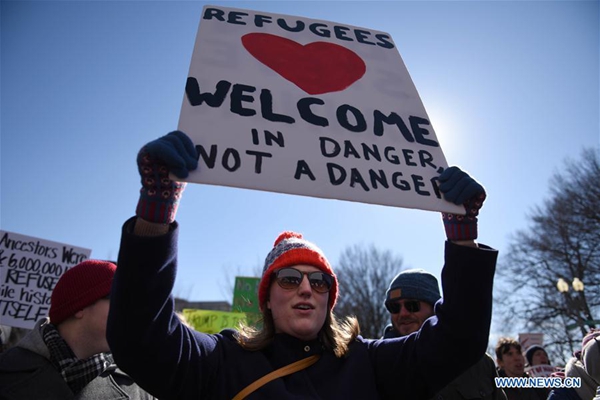Trump's travel ban
china.org.cn / chinagate.cn by George N. Tzogopoulos, February 16, 2017 Adjust font size:
|
|
|
Demonstrators participate in a protest against U.S. President Donald Trump's executive order barring U.S. entry to all regugees and seven Mideast and North African countries' citizens, in front of the White House, in Washington D.C., the United States, Feb. 4, 2017. Thousands of protesters took to the streets in Washington on Saturday to demonstrate against an executive order from U.S. President Donald Trump. (Xinhua/Yin Bogu) |
Donald Trump has started his presidency showing a sincere will to keep many of his pre-election promises while also testing the checks and balances system of American politics. As far as migration is concerned, he has encountered opposing court decisions in his effort to ban citizens of some countries from entering the U.S. All this has sparked unprecedented disagreement between the president and the judges challenging America's already divided democracy. Whoever prevails in the end, the trauma won't be easily healed.
Apart from the domestic and international interpretation of the debate, Trump's migration agenda was formulated before the presidential election. His speeches, interviews and remarks were published and widely distributed. So there is no element of surprise here. His decision to bar citizens from Syria, Iraq, Iran, Yemen, Libya, Somalia and Sudan from entering the country for 90 days and the suspension of the admission of all refugees for 120 days and for an indefinite period for those coming from Syria gives a practical taste of his approach. Within this framework, security procedures will be reviewed and the visa-issuance procedure will become more complicated and difficult, also with regard to travelers from the Visa Waiver Program (VWP) designated countries.
Trump's restrictions vis-à-vis migrants and refugees can hardly be assessed if no reference to modern American history is made. Specifically, in 1980, Congress passed The Refugee Act which created a program for the effective resettlement of refugees and the provision of assistance to them to achieve economic self-sufficiency. Approximately 3 million refugees have been resettled in the U.S. since then. It is important to mention that Trump is not the first U.S. president to stop the admission of refugees. George W. Bush adopted similar measures after the terrorist attacks of 9/11.
Historically, the total number of refugees coming to the U.S. has fluctuated over the past few decades. Different global events such as the end of the Cold War or the Balkan Wars and different priorities of Washington have influenced this fluctuation.
Under Trump, the total number of admissions is expected to be around 50,000 for the year. An analysis of data gathered by the Migration Policy Institute for the 21st century shows that this number does not significantly vary from that of many years of George W. Bush's and Barack Obama's administrations.
In 2005 and 2006 - under normal circumstances in the aftermath of 9/11 - the number was 53,813 and 41,223 respectively. Also, it was 56,424 in 2011 and 58,238 in 2012 respectively. In the last years of his presidency, Obama was more generous, attempting to keep his promises from his first year in office and also responding to the humanitarian crisis stemming from the Middle East turmoil. This being said, 70,000 refugees were admitted in fiscal year 2015 and 84,995 in fiscal year 2016.
At first glance, Trump's policy is consistent with American norms in the 21st century. It only differs from Obama's targets in the last years and is therefore considered as extreme by mainstream media. What is perhaps more problematic with Trump's travel ban is that it targets Muslims, although not exclusively.
State Department's Processing Center data demonstrate that Muslims made up nearly half (46 percent) of refugee admissions in 2016. And now Trump's executive order is concerned with several Muslim countries where extremism and terrorism are on the rise. No specific Muslim ban can be found in the official document. But this is certainly implied. A characteristic excerpt also states that when admissions of refugees resume, the U.S. will "prioritize refugee claims made by individuals on the basis of religious-based persecution, provided that the religion of the individual is a minority religion in the individual's country of nationality."
The good news for Donald Trump is that the ongoing negative media coverage does not necessarily reflect public opinion in the U.S. A Quinnipiac University national poll conducted in January shows that a 48 percent of American voters support "suspending immigration from terror prone regions, even if it means turning away refugees from those regions," as opposed to a 42 percent which disagree.
The bad news for the U.S. president, however, is that his method will not necessarily prevent more terror attacks or boost the U.S. economy. Last but not least, Trump is further widening the gap between himself and other world leaders. Many politicians and prominent figures have blasted him for employing divisive, insulting and discriminatory practices.
George N. Tzogopoulos is a columnist with China.org.cn. For more information please visit:
http://www.china.org.cn/opinion/GeorgeNTzogopoulos.htm
Opinion articles reflect the views of their authors, not necessarily those of China.org.cn.
